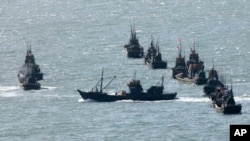China is ordering newly-built civilian ships to comply with military specifications. Analysts say the move could help bolster China’s efforts to assert its territorial claims in the disputed East and South China seas and add to ongoing efforts by the Chinese military to extend its naval reach.
Beijing has already expanded its civilian coast guard fleet into the largest in the world, using the unarmed ships to help shore up its claims in disputed waters, according to a U.S. naval intelligence report published earlier this year. This has led analysts to call the fleet “China’s Second Navy.”
Last week, Chinese state media reported the government has approved new national military guidelines that require private shipbuilders to build up reserve naval platforms on their new vessels to serve the navy in wartime.
China’s legislature will also begin work on a National Defense Transport Law that will help shipbuilders cover the costs of making ships suitable for military use and insurance to cover possible damage during military operations, the report said.
Boosting Strength
The requirements will “enable China to convert the considerable potential of its civilian fleet into military strength,” the official China Daily quoted China Classification Society as saying. The shipping certification organization has worked with the military over the past five years to finalize the requirements.
The report adds that as of last year, China had about 172,000 civilian ships.
China is in the midst of a rapid push to build up its navy and extend its reach farther from its shores. The Chinese navy is expanding its number of surface ships and submarines. It also commissioned its first aircraft carrier in recent years and, according to a recent report on the Chinese military from the U.S. Pentagon, it is likely to build multiple aircraft carriers over the next decade.
The new scheme for civilian vessels could be a signal of China’s increased determination in Asia said James Nolt, a senior fellow at the World Policy Institute.
“It may be intended to warn other countries in the region that China takes its claims in the South China Sea very seriously and may be willing to back them up with force in the future,” Nolt said. “So, it could be taken as a warning, but I wouldn’t assume automatically that that’s it.”
Nolt added that the practice of building naval auxiliaries is common among other nations because it is more economical to call on dual-purpose civilian ships if and when the need arises.
The United States has done so since World War I, as did Britain during the Falklands War in 1982. And now China is catching up.
Analysts say that based on Chinese reports about the plans it seems that the main inspiration for China’s push is a system of U.S. maritime laws that allow for the subsidizing and insurance of dual-use civilian ships.
Blue Water Navy
More importantly, the move could help support the Chinese Navy’s ambitions to build a blue-water fleet and extend its operations farther from its shores.
“It does represent a little bit of an evolution for China because, up until now, China hasn’t tried to do as many blue-water operations as it’s trying to do now. And the farther away they get from their own ports, the more they need some additional support from naval auxiliaries,” said Nolt.
According to state-media reports there are five types of civilian ships that will be required to meet the regulations: containers, roll-on/roll-off, multipurpose, bulk carriers and break bulk vessels. Among those, roll-on/roll-off ships would be particularly useful to transport military vehicles and equipment from local ports to half-way islands, Nolt added.
Still, it's too early to gauge how big a boost the scheme will be to strengthen China’s naval capabilities.
Dual Purpose
But at least for now, with schemes like this, China can put on a tough face in front of neighboring Asian countries. A brave face like this will immediately win Chinese leaders domestic clout, said Lin Chong-bin, a China defense analyst and former Deputy Defense Minister in Taiwan.
“Both China and [its] neighbors are gesturing. However, they know they cannot let the tension boil over into open military conflict. That would hurt their economies. Therefore, we see this thing I call toughness abroad yields domestic applause,” Lin said.
This gesturing is, in particular, of great importance for Chinese President Xi Jinping as he is pushing for a huge domestic reform package. Therefore, "he cannot afford to look weak externally,” he added.
When dealing with other nations, China's gesturing could also serve a diplomatic purpose, Lin said.
“This kind of gesturing would help Beijing to up its ante before Beijing leaders talk to Washington's leaders," he said.
China's President Xi Jinping will make his first state visit to Washington this September where he will hold talks with President Barack Obama.







